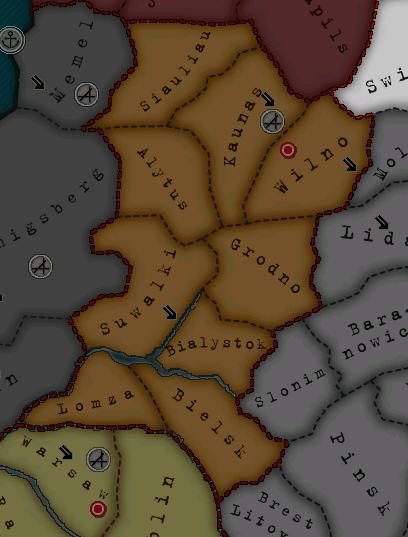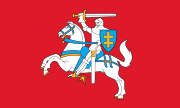Lithuania
From Kaiserreich
m (Reverted edit of Dinu, changed back to last version by AC) |
|||
| (5 intermediate revisions not shown) | |||
| Line 1: | Line 1: | ||
| - | [[Image:litplac.jpg| | + | {| border=1 align=right cellpadding=4 cellspacing=0 width=340 style="margin: 0 0 1em 1em; background: #f9f9f9; border: 1px #aaaaaa solid; border-collapse: collapse; font-size: 95%;" |
| + | |+<big><big>'''Lietuvos Karalystė'''<br>'''Königreich Litauen'''<br>'''Kingdom of Lithuania''' | ||
| + | </big></big> | ||
| + | | align="center" colspan="2"| | ||
| + | {| border=0 cellpadding=2 cellspacing=0 style="background:#f9f9f9; text-align:center;" | ||
| + | | | ||
| + | |- | ||
| + | | align=center colspan=2 | http://upload.wikimedia.org/wikipedia/commons/thumb/6/62/Flag_of_Lithuania_%28state%29.svg/180px-Flag_of_Lithuania_%28state%29.svg.png http://upload.wikimedia.org/wikipedia/commons/thumb/1/19/Coat_of_Arms_of_Lithuania.svg/85px-Coat_of_Arms_of_Lithuania.svg.png | ||
| + | <br> Flag and Coat of Arms of Lithuania | ||
| + | |} | ||
| + | |- | ||
| + | | align=center style="background:#f9f9f9;" font-size:95% colspan=2 | '''Motto'''<br>''Tautos jėga vienybėje <br>(The strength of the nation lies in unity)'' | ||
| + | |- | ||
| + | | align=center font-size:95% colspan=2 | '''Anthem''' <br>Tautiška giesmė | ||
| + | |- | ||
| + | | align=center colspan=2 | [[Image:litplac.jpg|300px]] | ||
| + | |- | ||
| + | |'''Official Languages''' || German | ||
| + | |- | ||
| + | |'''Capital''' || Wilnius | ||
| + | |- | ||
| + | |'''Head of State''' || [[Mindaugas III]] von Urach | ||
| + | |- | ||
| + | |'''Head of Government''' || [[Juonas Ambrazevicius]] | ||
| + | |- | ||
| + | |'''Establishment'''<br> - Treaty of Brest-Litovsk | ||
| + | |<br> March 3, 1918 | ||
| + | |- | ||
| + | |'''Government''' | ||
| + | |Parliamentary monarchy | ||
| + | |- | ||
| + | |'''Currency''' | ||
| + | |Papiermark | ||
| + | |- | ||
| + | |'''Area''' | ||
| + | |Approx 80 000 km² | ||
| + | |- | ||
| + | |'''Population''' | ||
| + | |About 3 millions | ||
| + | |- | ||
| + | |} | ||
| - | '''Lithuania''' (Lithuanian: ''Lietuva'') is one of the two Baltic countries in Europe | + | '''Lithuania''' (Lithuanian: ''Lietuva'') is one of the two Baltic countries in Europe; however, it does not have sea access. It is bordered by [[Germany]] to the west, the [[United Baltic Duchy]] to the north, [[White Ruthenia]] to the east and [[Poland]] to the south. |
| + | |||
| + | == History == | ||
| + | Following the Third Partition of [[Poland]] in 1795, Lithuania was split between the Russian Empire and Prussia, [[Russia]] getting most of the territory. After Napoleon's campaign in Russia ended in disaster, Tsar Nicholas I began an intensive program of Russification. The Lithuanians and Poles revolted twice, in 1831 and 1863, but both attempts failed. In 1864 the Lithuanian language and the Latin alphabet were banned in junior schools. Lithuanians resisted the Russification by arranging printing abroad and smuggling the books in. The national revival started among poor people in the late years of Russian occupation, then continued with the wealthy, beginning with the release of Lithuanian newspapers, Ausra and Varpas, then with the writing of poems and books in Lithuanian. These writings glorified the Grand Duchy of Lithuania, depicting the nation with power and many heroes. | ||
| + | |||
| + | This revival spearheaded the independence movement, with various organizations opposing Russian influence. Russian policy became harsher in response and there are known to have been strikes against Catholic churches, while a ban of the Lithuanian press still continued. Despite Russian attempts to integrate Lithuania by the end of the 19th century Lithuania had developed a growing nationalist movement. During the Russia-wide revolutionary upsurge of 1905 a congress of Lithuanian representatives in Vilnius on 5 December 1905 demanded provincial autonomy. | ||
| + | |||
| + | During the [[Weltkrieg]] Lithuania's occupation by [[Germany]] and the subsequent collapse of the Russian imperial government led to the proclamation of an independent republic on February 16, 1918 under German control, and full independence in November 1918. On the 11th of July 1918, King [[Mindaugas II]] (born as HSH Prince Wilhelm Karl Florestan Gero Crescentius of Urach, Count of Württemberg) was elected King of Lithuania and subsequently crowned in a grand ceremony in Vilnus in January 1920. Lithuania Minor was kept under German control, and the border settled between the [[United Baltic Duchy|German Baltic state]] and Lithuania meant that that the latter would be deprived of any sea access. Mindaugas II was succeeded following his death on the 24th of March 1928 by his son, crowned [[Mindaugas III]]. | ||
== Politics == | == Politics == | ||
| + | '''King of Lithuania''': J.K.D. [[Mindaugas III]] von Urach | ||
| + | |||
| + | '''Prime Minister''': [[Juonas Ambrazevicius]] | ||
| - | + | '''Foreign Minister''': Oskaras Milosas | |
| - | + | '''Armament Minister''': Valdemaras Vytautas-Carneckis | |
| - | + | '''Minister of Security ''': Antanas Smetona | |
| - | + | ||
| - | + | '''Head of Military Intelligence''': Dovas Zaunius | |
| + | |||
| + | '''Chief of Staff''': Jonas Galvydis-Bykauskas | ||
| + | |||
| + | '''Chief of Army''': Stasys Rastikis | ||
| + | |||
| + | '''Chief of Navy''': Garnis Dirmantas | ||
| + | |||
| + | '''Chief of Air Force''': Antanas Gustaitis | ||
| + | |||
| + | == Military == | ||
| + | The Lithuanian army comprise five infantry divisions, but is heavily reliant on the German system. The Lithuanian Air Force consist of a single squadron of interceptors. | ||
| + | |||
| + | == Foreign Relations == | ||
| + | Lithuania is part of the [[Mitteleuropa]] military and economic alliance. | ||
| + | |||
| + | Very good relations with [[Germany]] and other countries in Mitteleuropa. | ||
| - | + | Friendly relations with [[Poland]]. | |
| - | [[Category:Countries]] [[Category:European countries]] [[Category:Mitteleuropa]] | + | [[Category:Countries]] [[Category:European countries]] [[Category:Mitteleuropa]] [[Category:Monarchies]] |
Current revision as of 14:19, 29 December 2016
| ||||
| Motto Tautos jėga vienybėje (The strength of the nation lies in unity) | ||||
| Anthem Tautiška giesmė | ||||

| ||||
| Official Languages | German | |||
| Capital | Wilnius | |||
| Head of State | Mindaugas III von Urach | |||
| Head of Government | Juonas Ambrazevicius | |||
| Establishment - Treaty of Brest-Litovsk | March 3, 1918 | |||
| Government | Parliamentary monarchy | |||
| Currency | Papiermark | |||
| Area | Approx 80 000 km² | |||
| Population | About 3 millions | |||
Lithuania (Lithuanian: Lietuva) is one of the two Baltic countries in Europe; however, it does not have sea access. It is bordered by Germany to the west, the United Baltic Duchy to the north, White Ruthenia to the east and Poland to the south.
Contents |
History
Following the Third Partition of Poland in 1795, Lithuania was split between the Russian Empire and Prussia, Russia getting most of the territory. After Napoleon's campaign in Russia ended in disaster, Tsar Nicholas I began an intensive program of Russification. The Lithuanians and Poles revolted twice, in 1831 and 1863, but both attempts failed. In 1864 the Lithuanian language and the Latin alphabet were banned in junior schools. Lithuanians resisted the Russification by arranging printing abroad and smuggling the books in. The national revival started among poor people in the late years of Russian occupation, then continued with the wealthy, beginning with the release of Lithuanian newspapers, Ausra and Varpas, then with the writing of poems and books in Lithuanian. These writings glorified the Grand Duchy of Lithuania, depicting the nation with power and many heroes.
This revival spearheaded the independence movement, with various organizations opposing Russian influence. Russian policy became harsher in response and there are known to have been strikes against Catholic churches, while a ban of the Lithuanian press still continued. Despite Russian attempts to integrate Lithuania by the end of the 19th century Lithuania had developed a growing nationalist movement. During the Russia-wide revolutionary upsurge of 1905 a congress of Lithuanian representatives in Vilnius on 5 December 1905 demanded provincial autonomy.
During the Weltkrieg Lithuania's occupation by Germany and the subsequent collapse of the Russian imperial government led to the proclamation of an independent republic on February 16, 1918 under German control, and full independence in November 1918. On the 11th of July 1918, King Mindaugas II (born as HSH Prince Wilhelm Karl Florestan Gero Crescentius of Urach, Count of Württemberg) was elected King of Lithuania and subsequently crowned in a grand ceremony in Vilnus in January 1920. Lithuania Minor was kept under German control, and the border settled between the German Baltic state and Lithuania meant that that the latter would be deprived of any sea access. Mindaugas II was succeeded following his death on the 24th of March 1928 by his son, crowned Mindaugas III.
Politics
King of Lithuania: J.K.D. Mindaugas III von Urach
Prime Minister: Juonas Ambrazevicius
Foreign Minister: Oskaras Milosas
Armament Minister: Valdemaras Vytautas-Carneckis
Minister of Security : Antanas Smetona
Head of Military Intelligence: Dovas Zaunius
Chief of Staff: Jonas Galvydis-Bykauskas
Chief of Army: Stasys Rastikis
Chief of Navy: Garnis Dirmantas
Chief of Air Force: Antanas Gustaitis
Military
The Lithuanian army comprise five infantry divisions, but is heavily reliant on the German system. The Lithuanian Air Force consist of a single squadron of interceptors.
Foreign Relations
Lithuania is part of the Mitteleuropa military and economic alliance.
Very good relations with Germany and other countries in Mitteleuropa.
Friendly relations with Poland.


